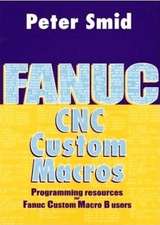Control Systems Design: A New Framework
Editat de Vladimir Zakianen Limba Engleză Hardback – 24 aug 2005
- basic principles, including those of matching and inequalities with adjustments for robust matching and matching based on H-infinity methods and linear matrix inequalities;
- computational methods, including matching conditions for transient inputs and design of a sampled-data control system;
- search methods including search with simulated annealing, genetic algorithms and evaluation of the node array method;
- case studies, including applications in distillation, benchmarking critical control of magnetic levitation systems and the use of the principle of matching in cruise control.
Preț: 956.33 lei
Preț vechi: 1166.26 lei
-18% Nou
Puncte Express: 1434
Preț estimativ în valută:
182.100€ • 195.68$ • 152.58£
182.100€ • 195.68$ • 152.58£
Carte tipărită la comandă
Livrare economică 18 aprilie-02 mai
Preluare comenzi: 021 569.72.76
Specificații
ISBN-13: 9781852339135
ISBN-10: 1852339136
Pagini: 416
Ilustrații: XIV, 398 p.
Dimensiuni: 155 x 235 x 28 mm
Greutate: 0.76 kg
Ediția:2005
Editura: SPRINGER LONDON
Colecția Springer
Locul publicării:London, United Kingdom
ISBN-10: 1852339136
Pagini: 416
Ilustrații: XIV, 398 p.
Dimensiuni: 155 x 235 x 28 mm
Greutate: 0.76 kg
Ediția:2005
Editura: SPRINGER LONDON
Colecția Springer
Locul publicării:London, United Kingdom
Public țintă
ResearchCuprins
Basic Principles.- Foundation of Control Systems Design.- Computational Methods (with Numerical Examples).- Matching Conditions for Transient Inputs.- Matching to Environment Generating Persistent Disturbances.- LMI-based Design.- Design of a Sampled-data Control System.- Search Methods (with Numerical Tests).- A Numerical Evaluation of the Node Array Method.- A Simulated Annealing Inequalities Solver.- Multi-objective Genetic Algorithms for the Method of Inequalities.- Case Studies.- Design of Multivariable Industrial Control Systems by the Method of Inequalities.- Multi-objective Control using the Principle of Inequalities.- A MoI Based on ?? Theory — with a Case Study.- Critical Control of the Suspension for a Maglev Transport System.- Critical Control of Building under Seismic Disturbance.- Design of a Hard Disk Drive System.- Two Studies of Robust Matching.
Textul de pe ultima copertă
In recent decades, a comprehensive new framework for the theory and design of control systems has emerged. This framework is based on a radically different foundation from the conventional approach. It treats a range of significant and ubiquitous design problems, including those of critical systems, more effectively than the conventional framework. Control Systems Design brings together contributions from the originators of the new framework in which they explain, expand and revise their research work in the field with more recent and entirely novel material.
The book also demonstrates how the conventional design framework can be made more effective by the use of the principle of inequalities. It is divided into four parts:
• basic principles, including those of matching and inequalities with adjustments for robust matching and matching based on H-infinity methods and linear matrix inequalities;
• computational methods, including matching conditions for transient inputs and design of a sampled-data control system;
• search methods including search with simulated annealing, genetic algorithms and evaluation of the node array method;
• case studies, including applications in distillation, benchmarking critical control of magnetic levitation systems and the use of the principle of matching in cruise control.
This book will be of great interest to academics and institutional researchers in control system design and to those studying for higher degrees in this area.
The book also demonstrates how the conventional design framework can be made more effective by the use of the principle of inequalities. It is divided into four parts:
• basic principles, including those of matching and inequalities with adjustments for robust matching and matching based on H-infinity methods and linear matrix inequalities;
• computational methods, including matching conditions for transient inputs and design of a sampled-data control system;
• search methods including search with simulated annealing, genetic algorithms and evaluation of the node array method;
• case studies, including applications in distillation, benchmarking critical control of magnetic levitation systems and the use of the principle of matching in cruise control.
This book will be of great interest to academics and institutional researchers in control system design and to those studying for higher degrees in this area.
Caracteristici
Presents a new way of doing control systems design more widely effective – in critical systems, for example – than the standard methods used before Gives the reader the complete framework from basic principles to real-world applications in one place for the first time












